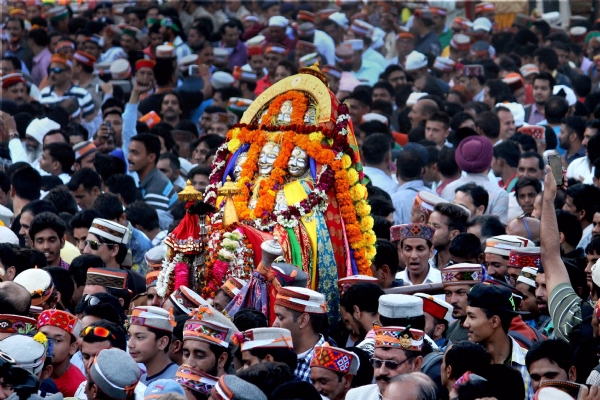Kullu Dussehra: The 372-Years-Old Unique Festival of Himachal Pradesh
05 Oct 2022 08:04:40
With the Celebration of the Vijaydashmi or Dussehra, a day that marks the victory of good over the bad, the nine-day festival of the Shakti has come to end in all parts of the Country. But do you know that, unlike other parts of India, there is one state in India that commences its Navratri celebrations when the rest of the country is winding up the festivities.

Yes, you read it right! We are talking about the 'Kullu Dussehra Festival', which starts on "Vijay Dashami. The festival, which starts on the tenth day of the rising moon and continues for seven days, The festival is celebrated with a lot of fervour in the picturesque valley of Himachal Pradesh. The festival is witnessed by around 4-5 million people from across the globe. This Dussehra celebration is slightly different from how Vijaydashmi or Dussehra is celebrated in the rest of India.
This week-long festival starts with a procession of Lord Raghunath, along with other deities, carried on a ratha across the town. The village gods and minor deities are also a part of this celebration.
The origins of this event may be traced back to the 16th and 17th centuries when a king of Kullu, Raja Jagat Singh installed an idol of Lord Raghunath on his throne on the advice of a Brahmin to eradicate his curse.
It is believed, one day during his regime, Raja learned about a priest in Kullu who possessed precious pearls. In his greed, he ordered the peasant to hand over the pearls or else be hanged. The priest, fearing torture and disgrace, set his house on fire with himself and his family and cursed the Raja. Out of guilt and self-disgust, Raja Jagat Singh began hallucinating. The spirit of the Brahmin continued to haunt him.
Finally, on the advice of Krishan Dutt, the Raja obtained an idol of Lord Raghunath from Ayodhya. This task was entrusted to Damodar Dass. However, Dass went missing while travelling with the god from Ayodhya. After a prolonged search, the pandit and the God were discovered on the banks of the Saryu River.
When the pandit arrived in Kullu, the Raja installed the idol near the Rupi Palace in Raghunathji's temple at Sultanpur. Priests were brought from Ayodhya to conduct special rituals for Raghunathji. Impressed by an idol, the king abdicated his crown and put an idol of Lord Raghunath (Lord Ram) on the empty throne, pledging that only the lord and his successors would rule the Kingdom of Kullu thereon. After this, Lord Raghunath was declared the ruling deity of the valley.'
It is believed that since then, Lord Raghunath has invited other gods from the heavens to celebrate Dussehra in Kullu. The celebrations became a symbol of pleasure and plenty in the state, with music, dance, colourful decorations, and a captivating atmosphere.
The celebration starts with the Chariot Journey, or Rathyatra, of Lord Raghunathiji. On a beautifully decorated chariot, the idol of the deity is saddled. The celebration starts at Dhalpur Maidan. The chariot is pulled with the ropes. Hundreds of devtas are brought to the temple ground on the day of Dussehra. Those idols are placed in decorated palanquins. The ropes of the chariot are pulled by the locals as they consider the act to be a very sacred one.
The Rathyatra of Raghunathjee from Sultanpur to Dhalpur starts in the afternoon. It is mandatory that Devi Hadimba of Dhungri, a village near Manali where her famous temple exists, first arrives at the Raghunathjee temple. She is regarded as the great-grandmother of the area Raja of Kullu is considered as the descendant of their dynasty.
The main attraction of Kullu Dussehra is the Rathyatra of Raghunathjee. The Rath is made of deodar wood with a huge wooden base, wooden wheels and a temple-like structure. The Raghunathjee’s idol is brought from Sultanpur in a palanquin accompanied by the Raja, priests, and bodyguards dressed in their traditional dresses. As soon as the Raghunath deity is seated the devotees of all the Devtas start playing their bands.
The three important days of Dussehra are the appearance of Thakar (Raghunathji), Muhalla (penultimate day of Dussehra), and Lanka Dahan (Burning of Lanka). The last day has an emblematic significance. Instead of burning effigies of Ravan, the festival concludes its celebration with the Lankadahan ceremony, or the burning of the Lanka (symbolised by dry leaves, grass, and twigs) on the banks of the river Beas. This ceremonious fire marks the burning of Lanka after "Lanka Dahan", a significant part of the Ramayana. It should be noted that the festival was declared an international event in 1972.
This time, Prime Minister Narendra Modi is also going to attend the famous Kullu Dussehra celebrations. As per the reports, he will be the first prime minister to attend the historical Dussehra event.
